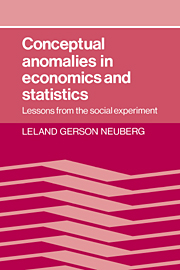Book contents
- Frontmatter
- Contents
- Preface
- Introduction
- PART I STATISTICAL LOGICS
- Chapter 1 J. S. Mill and some philosophical underpinnings of controlled experimentation
- Chapter 2 R. A. Fisher, randomization, and controlled experimentation
- Chapter 3 Some special difficulties of controlled social experiments
- Chapter 4 Hume's problem of induction in modern statistical inference and controlled experimentation
- Summary and conclusion of Part I
- PART II ECONOMIC LOGICS
- Conclusion: Some possible barriers to controlled social experiments as science
- Appendix: Proofs of theorems, lemmas, and propositions
- References
- Symbols and abbreviations
- Index
Chapter 3 - Some special difficulties of controlled social experiments
Published online by Cambridge University Press: 16 February 2010
- Frontmatter
- Contents
- Preface
- Introduction
- PART I STATISTICAL LOGICS
- Chapter 1 J. S. Mill and some philosophical underpinnings of controlled experimentation
- Chapter 2 R. A. Fisher, randomization, and controlled experimentation
- Chapter 3 Some special difficulties of controlled social experiments
- Chapter 4 Hume's problem of induction in modern statistical inference and controlled experimentation
- Summary and conclusion of Part I
- PART II ECONOMIC LOGICS
- Conclusion: Some possible barriers to controlled social experiments as science
- Appendix: Proofs of theorems, lemmas, and propositions
- References
- Symbols and abbreviations
- Index
Summary
Introduction: The nature of the object of inquiry and difficulties for causal inference
Fisher first employed his technique of randomization, together with the theory of causal inference formalized in the previous chapter, in agricultural experiments, where the group members were fields, or sections of fields, of crops, and the treatments were various sorts or amounts of soil enrichment or fertilizer. Only with concepts of “field” and “crop” radically at odds with common sense, then, could we say that Fisher's objects of inquiry were conscious or willful. Within a few decades of its introduction, though, randomization became a standard feature of biomedical drug-testing experiments, where the group members are human subjects and the treatments are various sorts or amounts of drugs. Thus, the human subjects of such drug-testing experiments are certainly conscious, in any ordinary sense of the term, and also creatures of will.
Physicians had early recognized that subject awareness in a medical experiment in which subjects had to be relied on to report results might lead to difficulties. For example, knowledge that they were taking a new aspirin tablet might lead subjects to report greater relief from their headache conditions than had actually occurred. To counteract such misreporting, physicians employ a so-called double-blind experiment, in which a treatment group receives the aspirin, and the control group gets a “placebo,” and neither subjects nor physicians know which group subjects are in. Recent historical research illuminates the origin of such techniques:
A few years later, both the medical Society in Vienna in 1844 and the Private Association of Austrian Homeopathic Physicians in 1856/57 were carrying out experiments on healthy humans in which both the testers and the tested were unaware of the medicine being used. […]
- Type
- Chapter
- Information
- Conceptual Anomalies in Economics and StatisticsLessons from the Social Experiment, pp. 61 - 88Publisher: Cambridge University PressPrint publication year: 1989



